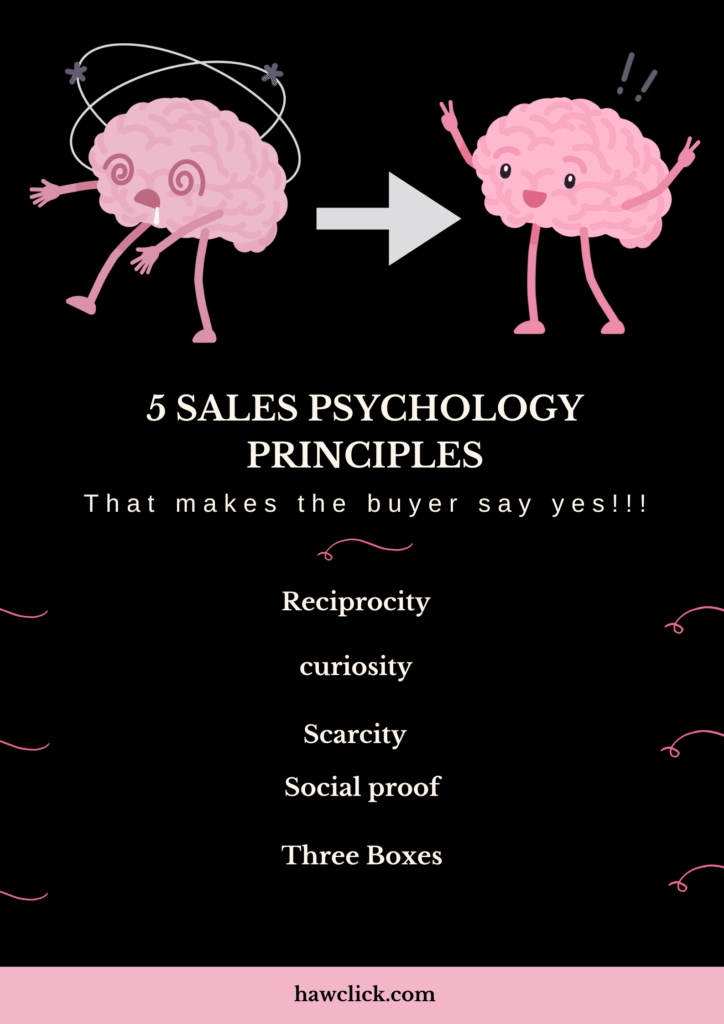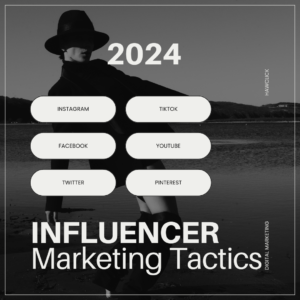Tara had launched her business with excitement, but without understanding the 5 Sales Psychology Principles (That Make the Buyer Say Yes!!!), her sales were largely a matter of luck. No matter how much she advertised, customers rarely bought—and she couldn’t figure out why. Everything changed when she met Alexis, a top-performing realtor who closes high-ticket deals with ease. Real estate is expensive, yet Alexis sells consistently, and her clients always return. Curious about her secret, Tara began learning the psychology behind why customers say “yes.”
What is sales psychology?
Sales psychology is the study of consumer behavior, emotions, and decision-making processes to improve sales and marketing strategies by focusing on emotional needs and psychological triggers rather than just product features. It involves understanding what motivates a customer to buy and using that knowledge to build rapport, overcome objections, and close deals by appealing to their wants and feelings.

1. Reciprocity: The Sales Psychology Principle That Instantly Makes Buyers Say “Yes!”
When it comes to the 5 Sales Psychology Principles (That Make the Buyer Say Yes!!!), one of the most powerful is reciprocity. This principle is simple: give something valuable, and people naturally feel compelled to give back.
Think about it — have you ever received a Christmas gift unexpectedly and immediately felt obligated to give something in return? That feeling is the foundation of reciprocity, and it works just as strongly in marketing.
Why Reciprocity Boosts Sales
Human beings are wired to return favors. When your audience receives something useful or thoughtful, they feel a social pressure to respond positively — often by trusting you more, subscribing, or making a purchase.
A classic example comes from a 1974 study by sociologist Philip Kunz. He mailed 600 handwritten Christmas cards to complete strangers and received over 200 replies. That’s reciprocity in action: when people receive something first, many feel compelled to respond.
How to Use Reciprocity in Your Marketing
✔️ Give a Freebie to Collect Leads
Offer something valuable upfront — a guide, checklist, template, or mini-course — in exchange for an email address or phone number.
This simple free offer sparks the reciprocity trigger, making people more willing to share their contact information and engage with your brand later.
✔️ Add a Personal Touch to Your Product Package
Small surprises create big results. Include a handwritten note or a discount in your customer’s package.
Example:
“Hi Agnes, thank you for your order! Enjoy 25% off your next purchase.”
This tiny gesture builds emotional connection and triggers the urge to return the favor — often by buying from you again.
Even a 5% discount combined with a friendly message can turn a one-time buyer into a loyal customer.
Why This Works
Reciprocity is a psychological principle that makes people feel valued and acknowledged. When used well, it dramatically boosts:
- Customer loyalty
- Email subscriptions
- Repeat purchases
- Brand trust
It’s one of the easiest and most effective sales psychology principles that makes buyers say YES.
2. Curiosity: The Psychology Trigger That Makes Buyers Click Instantly
When exploring the 5 Sales Psychology Principles (That Make the Buyer Say Yes!!!), curiosity is one of the most powerful tools you can use to increase clicks, engagement, and conversions. Curiosity works because it creates a mental itch — a knowledge gap people feel compelled to close.
Why Curiosity Works in Sales
Humans hate missing information. When you give your audience just enough to spark interest — but not the full story — they naturally want to know more. That desire pushes them to click your ad, open your blog post, or watch your video to the end.
How to Spark Curiosity (The Knowledge Gap Technique)
Curiosity is created by telling your audience something… but not everything.
Use headlines or hooks that reveal a benefit or result, but withhold the “how,” “why,” “what,” or “which.” This creates an internal tension that forces readers to click for answers.
Examples that instantly trigger curiosity:
- “31 Animals You Won’t Believe Actually Existed”
- “Don’t Eat These Foods on an Airplane”
- “Why Some People Are Getting Richer – Real Study”
- “Which Country Is the Worst to Travel Alone?”
- “How I Learned Handstanding in 4 Days”
You feel the urge to click because your brain wants to close the information gap.
Power Words That Trigger Curiosity
These words are essential for crafting irresistible headlines:
What, Why, Which, How, Won’t, Don’t, Secrets, Revealed, Discover
Using them in your ads, blog titles, emails, and content dramatically increases engagement.
Techniques to Keep Readers Engaged
Curiosity doesn’t end at the headline — you must hold attention inside the content too. Here’s how:
✔️ Drop Information in Small Pieces
Give a little info… pull back… then reveal more later.
This keeps your audience hooked all the way through.
Example introduction:
“A little over a year ago, I started my digital marketing agency. I signed my first client in 13 days, and it made me more money than I expected. I’ll explain exactly how in a second…”
This works because you:
- Reveal a specific result
- Share a hint of the strategy
- Promise the full story later
Readers stay because they don’t want to miss the full explanation.
✔️ Use List Headlines
Lists naturally build curiosity because people want to see each item.
- “10 Best Tools for Marketers”
- “31 Animals You Didn’t Know Existed”
- “7 Habits of Millionaires You Can Copy Today”
People keep scrolling because they want to see what’s next.
✔️ Tease a Reward at the End
Many YouTubers and bloggers use this well:
“Stay until the end — I’ll reveal a bonus tip.”
This gives readers a reason to stay instead of bouncing.
Avoid Clickbait — It Destroys Trust
Curiosity is powerful, but never promise what you can’t deliver. Clickbait leads to:
- High bounce rates
- Low trust
- Weak brand reputation
Be intriguing, but always truthful.
Before publishing, ask a friend:
“Would you click this?”
If not, adjust your headline until it sparks curiosity.
Curiosity is a psychological magnet. When used correctly, it increases:
- Click-through rates
- Time on page
- Conversions
- Sales
This is exactly why curiosity is one of the most effective sales psychology principles that make the buyer say YES.
3. Scarcity: The Sales Psychology Principle That Triggers Instant Action
Among the 5 Sales Psychology Principles (That Make the Buyer Say Yes!!!), scarcity is one of the strongest motivators. When people believe a product is limited — in stock or in time — their desire to buy increases instantly. That emotional pull is known as FOMO (Fear of Missing Out).
What Is Scarcity in Sales?
Scarcity is simply when demand feels higher than supply.
Imagine today was the last day anyone on earth could buy chocolate. Even if you hardly eat chocolate, you’d probably stock up. Why?
Because the moment something feels limited, its perceived value skyrockets.
This same principle applies in marketing, especially during events like Black Friday — where people fight over deals because they’re afraid of missing out.
Why Scarcity Makes Buyers Say “YES”
Scarcity creates:
- Urgency
- Pressure
- Emotional desire
- Quick decision-making
Customers act now because they believe the offer won’t be available later.
How to Use Scarcity in Your Marketing
✔️ 1. Limited-Time Offers
A deadline forces instant action. Examples: “20% off — Today only!” “Offer expires at midnight.”
Adding a countdown timer on your website or product page makes the urgency feel real.
Example message:
“Order within 5 hours to get it delivered by Friday.”
If a customer wants fast delivery, the clock pushes them to buy now.
✔️ 2. Flash Sale Countdowns
Flash sales perform incredibly well on social media ads and product pages.
Example:
- “4 hours left — Get 25% off your order!”
The ticking clock increases click-through rates, especially when paired with a strong discount.
✔️ 3. Limited Stock Alerts
This is scarcity at its strongest. When people know there are only a few items left, they move fast.
Examples you see everywhere:
- “Only 1 left in stock!”
- “7 people are viewing this hotel right now.”
Travel platforms like Booking.com use this tactic constantly — and it works because nobody wants to lose the last available option.
✔️ 4. Limited Access Offers
Perfect for digital products:
- Webinars
- Online courses
- Membership enrollments
Example:
“Registration closes in 19 minutes.”
Deadlines increase sign-ups because people don’t want to wait months for the next chance.
The Golden Rule: Always Be Honest
Scarcity works — but only when it’s real.
Fake countdowns and false “limited stock” claims destroy trust.
Use scarcity:
- When stock is genuinely low
- When a sale truly ends
- When a webinar or course is closing soon
Honesty builds long-term customers.
Scarcity creates urgency, triggers FOMO, and accelerates buying decisions — making it one of the most reliable sales psychology principles that make buyers say YES.
4. Social Proof: The Psychology Principle That Makes Buyers Trust You Instantly
When breaking down the 5 Sales Psychology Principles (That Make the Buyer Say Yes!!!), social proof is the shortcut to earning trust and increasing conversions. People naturally rely on the opinions and actions of others before making a decision — and that’s exactly why social proof works.
What Is Social Proof in Sales?
Social proof is the influence created when people see others using, liking, or recommending a product.
Before we buy anything — a book, a course, a gadget — we look for validation. Think about it: You’re browsing Amazon for a new Kindle book. The title alone doesn’t convince you. So what do you do? You scroll straight to the reviews. Those comments and star ratings determine whether you buy or keep searching. That’s social proof in action — we trust the experiences of others more than the seller’s promises.
Why Social Proof Makes Buyers Say YES
Because humans follow patterns. If others approve something, we assume it’s safe, valuable, and worth our money.
That’s why:
- A book becomes a bestseller
- A course goes viral
- Influencers attract millions of followers
People trust what the crowd validates.
How to Use Social Proof to Boost Sales
✔️ 1. Display Reviews
If you sell a product, book, or course, reviews are your strongest trust builders.
Example: A “Get Out of Debt” course with:
- A 4.5-star rating
- 2,000+ reviews
- Comments like: “This course is a perfect match for me!”
Even simple reviews increase credibility because they show real people found value in your offer.
✔️ 2. Add Testimonials (With Photos)
Testimonials go a step deeper than reviews.
A strong testimonial includes:
- A profile photo
- A real name
- A personal, specific experience
Example:
⭐⭐⭐⭐⭐
“The way Robin and Jasper break everything down step-by-step made it easy to follow. I highly recommend this to anyone who wants to get out of debt fast.”
— Rachel Wilson
Testimonials convert because they feel personal and relatable.
Pro tip:
You can offer a free product or bonus in exchange for detailed testimonials — especially when starting out.
✔️ 3. Use Case Studies (Results + Storytelling)
Case studies are powerful because they show real transformation.
Example case study:
“We helped Sarah eliminate $25,000 in debt in just 15 months.”
[Read My Story]
Why this works:
- It shows real measurable results
- It uses storytelling to create emotional connection
- It allows potential customers to picture their own transformation
Story-driven case studies can dramatically increase conversion rates.
✔️ 4. Social Media Credibility
Numbers talk. When people see a public figure with millions of followers (like Gary Vaynerchuk or Tony Robbins), it instantly signals expertise and authority.
Large audiences = strong social proof.
You can apply the same by showcasing:
- Follower counts
- Subscriber numbers
- Engagement stats
- User-generated content
- Customer photos
Where to Use Social Proof
You can integrate social proof across every marketing channel:
- Website (sales pages, landing pages, product pages)
- Emails
- Facebook & Instagram ads
- Social media content
- Checkout pages
- Lead generation pages
Every customer wants reassurance — give them proof early and often.
Why Social Proof Works
Because we trust:
- Reviews
- Ratings
- Real stories
- Real faces
- Real results
It’s the same reason we check IMDB before watching a movie — we want to know what others think before we commit. When done right, social proof guides potential buyers toward one conclusion:
👉 If it worked for others, it will work for me.
That’s how social proof triggers more sales and more YES decisions.
5. The Three Boxes
What Is the Three Boxes Technique?
The main purpose of this technique is simple:
👉 Move your customer from “Do I want to buy this?” to “Which one should I choose?” Instead of deciding yes or no, their brain shifts to choosing between your options.
Why One Offer Fails
Let’s start with an example from the gym industry.
Now, imagine a new client walking in. They’ve never hired a trainer before. They don’t know what they’re buying. All they see is:
- A price ($700)
- Uncertainty (Will this work for me?)
- Risk (Is it worth it?)
So naturally, they hesitate.
This is what happens when you only offer ONE choice.
Introducing More Options
Instead of a single package, our gym introduced three:
- Starter Package — 10 hours: $699
- Real Results Package — 20 hours: $1,400
- Transformation Package — 50 hours: $3,500
Now look at what happens inside the customer’s mind:
- 10 hours suddenly doesn’t look so “expensive” anymore
- 20 hours looks like the sweet spot
- 50 hours feels premium, but maybe too much for someone new
They’ve now mentally moved from:
“Should I buy this?” → “Which one fits me best?”
And that’s exactly what we want.
The 20–60–20 Rule
When you use this three-box layout, customer behavior follows a predictable pattern:
- 20% choose the cheapest option
- 60% choose the middle option
- 20% choose the premium, high-value option
The middle offer almost always becomes your best seller—because it’s psychologically the “safe choice.”
Why This Works
Customers compare value, not just price.
When they see three options, they naturally want the one that feels:
- Safe
- Reasonable
- Not too cheap
- Not too expensive
This is why the middle offer usually dominates sales.
Use This in Your Business
If you have one product or service, don’t just sell it alone.
Instead:
- Create a lighter version
- Position your main offer as the middle option
- Create a premium, all-inclusive option
This changes everything.
Your customer stops thinking “Should I?”
They start thinking “Which one?”
Conclusion
The Three Boxes technique works because it shifts your customer’s decision-making process. Instead of debating whether or not to buy, they simply choose the package that fits them best.
Apply this strategy to your own products or services, and you’ll see the difference immediately.


